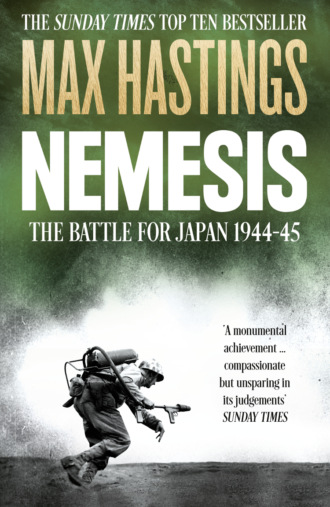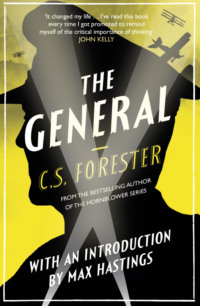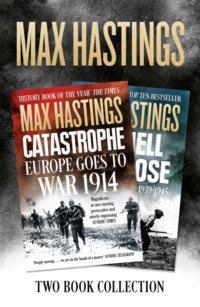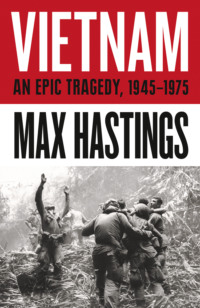
Полная версия
Nemesis: The Battle for Japan, 1944–45
This was an encounter MacArthur had not sought, did in fact scorn. George Marshall and Dwight Eisenhower, together with every other American, British, Soviet, German and Japanese commander of the Second World War, acknowledged subordination to their respective national leaderships. MacArthur, by contrast, seemed to reject accountability to any earthly power. His formal title was Allied Supreme Commander, South-West Pacific Area—SWPA. He seldom commanded more than ten divisions committed to combat operations, a fraction of Eisenhower’s army in north-west Europe. Indeed, in 1944 he controlled fewer than half the number of ground troops deployed in Italy, itself a secondary commitment. It was a source of bitter chagrin that he was denied overall theatre authority, and obliged to acknowledge Admiral Chester Nimitz, commanding US forces in the central Pacific, as his equal and rival. MacArthur had always opposed the ‘twin-track strategy’, whereby his elements approached Japan from the south-west, while the navy and Marines conducted their own thrusts further north. He believed that he alone was the appropriate arbiter of America’s eastern war, and fumed at the waste of resources caused by fighting two parallel campaigns, while never deigning to address the possibility that his own was the obvious candidate for redundancy.
Throughout his tenure of high command MacArthur, sixty-four in July 1944, bore controversy in his wake. From the day he graduated first of his West Point class, his intellect and inspirational leadership were recognised. As US Army chief of staff, however, he earned notoriety for his ruthless suppression of the 1932 World War I veterans’ ‘bonus march’ on Washington. His policy reflected perfervidly right-wing political convictions. Following his retirement in 1935 he returned to the Philippines, the American dependency where he had served in his youth, accepting the appointment of military adviser to its government and commander of its armed forces. As the Japanese threat grew, in July 1941 Roosevelt named MacArthur commander-in-chief of the American garrison as well as of the Filipino troops in the islands. In this capacity the general directed the defence of the islands from their invasion by the Japanese in December 1941 until March 1942. He was then ordered by the White House to escape by PT-boat before the surrender of his starving soldiers, trapped on the Bataan peninsula.
Army insiders held MacArthur personally culpable for the Philippines débâcle, by failures both of commission and omission. This was unjust. Though his generalship was poor, no commander could have defeated the Japanese onslaught with the weak forces at his disposal. More than a few American senior officers, however, would have been happy to see this elderly autocrat play no further role in the war. Eisenhower, who had served under MacArthur, expressed in his diary during the Bataan siege a belief that it would be a mistake to evacuate him: ‘If brought out, public opinion will force him into a position where his love of the limelight may ruin him.’ MacArthur displayed a taste for fantasy quite unsuited to a field commander, together with ambition close to megalomania and consistently poor judgement as a picker of subordinates. Fortunately for his public image, only Roosevelt and a handful of others were aware of the general’s acceptance in March 1942 of $500,000 from the Philippines Treasury, as a personal gift from President Manuel Quezon. This was an extraordinarily improper transaction on the part of both donor and recipient.
The British always acknowledged that their own forces and commanders performed poorly in the 1941-42 Burma and Malaya campaigns. Operations in the Philippines were equally mismanaged, but in those dark days Americans yearned for heroes. President and people colluded to make one of MacArthur, to forge a heroic myth around the defender of Bataan. Americans found it unthinkable that the US army which slowly assembled in Australia through 1942 and 1943 should be led into battle by anyone else.
MacArthur presided over campaigns to regain dominance of New Guinea and the islands of the south-west Pacific which proved protracted and bitter, and at first yielded little glory. Yet so formidable was the general’s publicity machine, so impressive his personality, that he held his job until the victories began to come. There were demands from the US political right that he should be made the nation’s global supreme commander, or accept nomination as a presidential candidate, neither of which notions he seemed eager to dismiss. Foremost among proponents of the ‘man of destiny’ view of history, he was bent upon becoming the lone star of America’s Pacific war. Everything within his compass was subordinated to that purpose. A blizzard of personal publicity accompanied his every movement, readily supported by US newspaper moguls—Hearst, McCormick, Patterson—who loved the general. Twelve full-length biographies were published in the course of the war, their flavour conveyed by a sample title, MacArthur the Magnificent, which did nothing to check his egomania.
The senior Allied commander who afterwards spoke most warmly of MacArthur was Gen. Sir Alan Brooke, the dour, clever Northern Irishman who was Britain’s principal wartime chief of staff. Brooke’s assessment was astonishingly effusive: ‘From everything I saw of him, he was the greatest general of the last war. He certainly showed a far greater strategic grasp than Marshall.’ Such a testimonial should not be altogether ignored, but Brooke knew little of either MacArthur or the Japanese war. Top Americans obliged to work with the ‘hero of Bataan’ adopted a much more sceptical view. His fitness for high command was disputed by many senior officers, foremost among them the Chief of Naval Operations Admiral Ernest King, another Olympian autocrat. King’s daughter described her father as an entirely even-tempered man: ‘He was always angry.’ Such was the admiral’s personal animus against the general that, at a joint chiefs of staff meeting, Marshall—himself no admirer of MacArthur—felt obliged to thump the table and silence a tirade from King: ‘I will not have any meeting carried on with this hatred.’
MacArthur’s critics believed that an advance across the south-west Pacific was irrelevant to America’s strategic requirements, and was promoted only by the general’s ambition to liberate the Philippines. He shamelessly manipulated communiqués about his forces’ achievements, personally selected photographs of himself for press release, deprived subordinates of credit for successes, shrugged off his own responsibility for failures. He was a man of fierce passions, whom ‘joy or sorrow would set…off on lusty zooms or steep dives’, in the words of a subordinate. ‘At the risk of being naive and just plain dumb,’ wrote Maj.-Gen. St Clair Streett, later commander of the Thirteenth Air Force, assessing Pacific command in October 1942, ‘the major obstacle for a sane military solution of the problem [is] General MacArthur…even the President himself might find his hands tied in dealing with the general.’ The sooner MacArthur was out of the Pacific, thought Streett, the sooner would it be possible to establish a rational command structure for the theatre.
A senior British airman, no stranger to tensions in his own nation’s high command, was nonetheless awed by those between America’s armed forces: ‘The violence of inter-service rivalry…in those days had to be seen to be believed, and was an appreciable handicap to their war effort.’ Even where armed services dislike each other institutionally, successful cooperation can be achieved if individual commanders forge working relationships. MacArthur, however, was interested in achieving harmony only in pursuit of his own objectives. Admiral King likewise placed the long-term interests of the US Navy far above any tactical conveniences related to fighting the Japanese. No overall Pacific supreme commander was ever appointed, because neither army nor navy could stomach the explicit triumph of the other service. And even if the resultant division of authority impeded the defeat of Japan, so prodigious were US resources that the nation felt able to indulge it.
MacArthur was never ill. When there was nowhere more distant to go, he paced his office to assuage his chronic restlessness. He made no jokes and possessed no small talk, though he would occasionally talk baseball to enlisted men, in attempts to deceive them that he was human. Marshall observed that MacArthur had a court, not a staff. Intimates of the ‘Bataan gang’, the handful of officers to whom he granted passages alongside his own family on the PT-boats escaping from the Philippines, remained privileged acolytes to the war’s end. SWPA chief of staff Lt-Gen. Richard Sutherland felt able to commission his Australian mistress in the American Women’s Army Corps, shipping her in his entourage until the scandal was exposed.
MacArthur’s belief that his critics were not merely wrong, but evil, verged on derangement. He claimed to perceive a ‘crooked streak’ in both Marshall and Eisenhower, two of the most honourable men in American public service. When the Office of War Information wished to alter for national consumption his legendary remark on quitting the Philippines from ‘I shall return’ to ‘We shall return,’ MacArthur demurred. Early in 1944, the general wrote to Stimson: ‘These frontal attacks by the Navy…are tragic and unnecessary massacres of American lives…The Navy fails to understand the strategy…Give me central direction of the war in the Pacific, and I will be in the Philippines in ten months…don’t let the Navy’s pride of position and ignorance continue this great tragedy to our country.’ MacArthur’s personal behaviour was no worse than that of Patton and Montgomery, but he exercised command under far less restraint than either.
Perhaps most distasteful of all his wartime actions was a flirtation with a 1944 presidential election run against Roosevelt, whose liberalism affronted his own rabidly conservative convictions. MacArthur’s staff corresponded with potential campaign backers in the US, which they could not have done without his knowledge. Lt-Gen. Robert Eichelberger asserted: ‘If it were not for his hatred, or rather the extent to which he despises FDR, he would not want [the presidency].’ The influential New York Times columnist Arthur Krock wrote in April 1944: ‘It is generally believed…that General MacArthur is dissatisfied with the military strategy of the war as approved by the President and Prime Minister Churchill.’ This was indeed so. Only when it became apparent that MacArthur could not defeat Thomas Dewey to secure the Republican presidential nomination did he finally exclude himself from candidacy.
He also possessed virtues, however. His air chief, George Kenney, observed shrewdly that ‘As a salesman, MacArthur has no superiors and few equals.’ The USAAF responded to the general’s enthusiasm for air power by offering its passionate support to his causes. Though MacArthur’s hostility towards Britain was well-known, British Brigadier Jack Profumo, attached to his staff, praised his private courtesy and warmth. The supreme commander’s senior British liaison officer described him to Churchill as ‘ruthless, vain, unscrupulous and self-conscious…but…a man of real calibre with a vivid imagination, a capacity to learn rapidly from the past, a leader of men…[with] a considerable understanding of personalities and political development’. MacArthur’s serene assurance, natural authority and charisma, lent some substance to his claims to rank. If he was not among history’s outstanding commanders, he acted the part of one with unshakeable conviction.
In late summer 1944, MacArthur’s credit as a strategist stood higher than it ever had before, or would again. In two months he had conducted a dramatic advance 1,200 miles up Papua-New Guinea, bypassing rather than lingering to destroy Japanese garrisons, staging a series of surprise amphibious assaults, of which the most recent and successful took place at Hollandia, where his headquarters was now being transferred. These achievements, however, won headlines without removing fundamental doubts about the usefulness of the army’s operations in the south-west Pacific, now that the threat to Australia was lifted. Geographical imperatives made the US Navy lead service in the Japanese war, to which the Army was obliged to defer. Soldiers could nowhere engage the Japanese without being transported to objectives in ships, and supported in action by fleets. MacArthur could bend strategy and sustain his own status as the most famous American participating in the struggle. But try as he might, he could not contrive absolute personal mastery.
This, then, was the background against which the supreme commander of SWPA arrived on Oahu, Hawaii, in July 1944, to meet Roosevelt and Nimitz. MacArthur’s tardy arrival reflected his distaste for the encounter. If he chafed at the need to parley by signal with the joint chiefs of staff in Washington, he found it intolerable to be obliged to fly several thousand miles to confer with a civilian politician, albeit the greatest in the land. MacArthur believed that Roosevelt had summoned the Hawaii meeting for political purposes, to further his re-election campaign by showcasing himself before the American people as their commander-in-chief. ‘The humiliation of forcing me to leave my command to fly to Honolulu for a picture-taking junket!’ the general exclaimed furiously during the twenty-six-hour flight from Australia. For once, his paranoia was probably justified. His scepticism about the Hawaii meeting was shared by Admiral King. Roosevelt was always party to the big decisions, and on several important occasions—for instance, when he insisted upon the November 1942 North African landings despite the deep reluctance of his chiefs of staff—he dictated them. Nonetheless, US strategy in the Second World War was dominated by compromises between rival service chiefs. This explains the curled lips of King and MacArthur when, in July 1944, Roosevelt sought to be seen to play the part of supreme warlord as he offered himself to the American people for an unprecedented fourth term.
The struggle with Japan had moved many thousands of miles since the Hawaiian islands fell victim to the 7 December 1941 air assault, but they remained America’s principal rear base and staging area for the Pacific campaign. ‘Pearl was mostly brass and hookers,’ in the laconic words of cruiser bosun’s mate Eugene Hardy. Combat officers who visited the islands’ headquarters complexes were irked by the sybaritic comfort in which staffs did their business. Regular Saturday-night dances were held at Schofield Barracks. ‘There were dinner parties, beach parties and cocktail parties,’ wrote a Marine general, O.P. Smith. ‘At some of the parties the women guests wore evening gowns. You had the feeling that you were half in the war and half out of it.’ Personnel based on Hawaii shrugged that it would give no help to the men at the sharp end to impose a spurious austerity. After protests by visitors from the combat zone, however, officers’ clubs abandoned the practice of serving steak twice a day.
Roosevelt’s most important meetings on Hawaii took place at the Kalaukau Avenue mansion of a prominent Waikiki citizen, Chris Holmes. Naval aviators had been billeted there for some time, and for a week before the grandees’ arrival, working parties from the submarine base laboured overtime to repair the fliers’ depredations. The house then became the setting for performances by two remarkable thespians, the president and the general of the army, together with a supreme professional, the Pacific Fleet’s C-in-C. The only issue which interested MacArthur was resolution of the Pacific route by which the US should continue its advance upon Japan. Even as Roosevelt, Nimitz and MacArthur conferred, the US Navy and Marines were completing the capture of the Mariana island group. On 19 and 20 June 1944, in the ‘great Marianas Turkey Shoot’, carrier planes of Admiral Raymond Spruance’s Fifth Fleet had inflicted devastating defeat, indeed near annihilation, upon Japan’s naval air force. Around 475 enemy aircraft were destroyed, by comparison with the sixty Luftwaffe planes shot down by the RAF on 15 September 1940, biggest day of the Battle of Britain. The island chain, a mere 1,400 miles south-east of Japan, represented a vital link in the American advance. Its capture made possible the construction of air bases from which B-29 bombers could reach Tokyo. Its loss was by far the most important Japanese defeat of 1944, a decisive moment of the war.
Because no minutes were taken of Roosevelt’s meetings with his commanders, uncertainty has persisted about exactly what was said. The historical narrative relies on fragmentary and highly partial accounts by the participants. ‘Douglas, where do we go from here?’ Roosevelt asked. This form of address must have irked MacArthur, who signed even letters to his wife Jean with his surname. ‘Leyte, Mr President, and then Luzon!’ was the recorded response, naming two of the foremost Philippine islands. These exact words are implausible, for at that stage US plans called for an initial landing further south, on Mindanao. The thrust of MacArthur’s argument is not in doubt, however. He asserted, as he had done since 1942, that strategic wisdom and national honour alike demanded the liberation of the Filipino people, whose territory would then become the principal stepping stone for the invasion of Japan.
In October 1943, the joint chiefs had allocated the US Navy its own route across the central Pacific via the Marshall, Caroline and Mariana islands, assaulted principally by Marine divisions, while MacArthur’s soldiers advanced by way of the Solomons, the Bismarck Archipelago, and the hills and jungles of Papua-New Guinea. All these objectives were now achieved. The names of their torrid conquests had become written in blood into American history: Guadalcanal and Kwajalein, Tarawa, Saipan and Guam. Each had been the scene of a contest for a few square miles of rock or coral on which to create airstrips and anchorages to support the greatest fleets the world had ever seen. The Pacific war was fought almost entirely within gunshot of the sea. Amid the vast, empty expanses of the world’s largest ocean, men flung themselves upon outcrops of land, painted livid green by vegetation, with a passion mocked by their coarse beauty. In the first eighteen months of the conflict, though Japan’s supply lines were grossly over-extended, her armed forces engaged the Americans on not unequal terms. Until late 1943, for instance, the US Pacific Fleet never possessed more than four aircraft carriers. Thereafter, however, American strength soared, while that of Japan shrank.
A host of ships, planes, men and guns flooded west from the US to the battlefields. At peak production in March 1944, an aircraft rolled out of an American factory every 295 seconds. By the end of that year, almost one hundred US aircraft carriers were at sea. American planes and submarines were strangling Japanese supply routes. It had become unnecessary systematically to destroy Japan’s Pacific air bases, because the enemy possessed pitifully few planes to use them. Between 26 December 1943 and 24 October 1944, Japanese aircraft failed to sink a single significant American ship. Similarly, surviving Japanese army garrisons presented no threat, for Tokyo no longer had means to move or supply them. But even when the Japanese strategic predicament was hopeless, when resistance became—by Western lights—futile, their soldiers fought to the last. These desperate battles reflected, in some degree, the warrior ethic of bushido. Overlaid upon this, however, was a rational calculation by Tokyo. The superiority of American resources was manifest. If Japan pursued the war within the limits of conventional military behaviour, its defeat was inevitable. Its leaders’ chosen course was to impose such a ghastly blood price for each American gain that this ‘nation of storekeepers’ would find it preferable to negotiate, rather than accept the human cost of invading Japan’s main islands. If such a strategy was paper-thin, and woefully underestimated American resolution, it determined Japanese conduct by land, sea and air until August 1945.
‘No matter how a war starts, it ends in mud,’ wrote Gen. ‘Vinegar Joe’ Stilwell. ‘It has to be slugged out—there are no trick solutions or cheap shortcuts.’ There was, and remains, no doubt that this was true of the war against Germany. But did it also apply to the war against Japan? The enemy was an island nation. If the US Navy could secure sufficient Pacific footholds to provide air and naval basing facilities on the route to Japan, was it also necessary to fight a major ground campaign? It had been America’s historic intention to conduct any war with Japan at sea and in the air, rather than by land battle. Whatever the achievements of US ground forces since Pearl Harbor, the decisive victories had been secured by the navy—Midway and the progressive attrition of Japan’s air and naval forces. While American strategic planning assumed eventual amphibious landings in the Japanese home islands, it remained the fervent hope of most commanders that blockade and air bombardment would render these unnecessary.
There was only one messianic advocate of a major campaign to retake the Philippines: MacArthur. While others varied their opinions in the face of changing circumstances, the general never did. It is possible that beyond ego, a worm of guilt gnawed, about his own conduct in 1941-42. Albeit under presidential orders, he had abandoned his Philippines command to barbarous captivity, to flee with his personal staff, family, nanny and dubiously-acquired fortune to safety in Australia. Now, when other commanders’ eyes flitted between alternative objectives in the western Pacific, his own never wavered. King, an officer as imperious as MacArthur, favoured bypassing the Philippines, approaching Japan by way of its offshore island possessions, Formosa and Okinawa. Formosa presented a much smaller target than the mass of the Philippines, with the additional attraction of opening a gateway to the Chinese mainland.
The US Army’s War Plans Department concluded as far back as 1923 that, if America’s Philippines bases were lost in the early stages of a conflict, their recapture would be ‘a long and costly undertaking’. King complained that MacArthur was drawn to the islands solely by sentiment. Marshall likewise warned the general in June 1944: ‘We must be careful not to allow our personal feelings and Philippine political considerations to override our great objective, which is the early conclusion of the war with Japan…bypassing [is not] synonymous with abandonment.’
On Hawaii, when Roosevelt expressed concern about the human cost of retaking the Philippines, MacArthur said: ‘Mr President, my losses would not be heavy, any more than they have been in the past. The days of the frontal attack are over. Modern infantry weapons are too deadly, and direct assault is no longer feasible. Only mediocre commanders still use it. Your good commanders do not turn in heavy losses.’ This was self-serving bluster. It reflected MacArthur’s disdain for the navy’s conduct of the central Pacific thrust, and ignored the fact that Nimitz’s forces met far stronger Japanese defences than his own had been obliged to face; in the course of the Pacific war, MacArthur’s casualties in reality exceeded those of Nimitz.
But no significant opposition to MacArthur’s Philippines ambitions was expressed. Six hours of meetings were dominated by Roosevelt and MacArthur. Nimitz merely outlined plans for an amphibious landing to establish bases on Peleliu, east of the Philippines, and described the progress of fleet operations. The main dish at the big formal lunch which punctuated discussion was the famous Hawaiian fish mahimahi, examined and approved as fit for presidential consumption by Vice-Admiral Ross McIntire, FDR’s personal physician. MacArthur was able to say of his relations with the naval C-in-C: ‘We see eye to eye, Mr President, we understand each other perfectly.’
Robert Sherrod wrote of Nimitz, one of the greatest naval officers America has produced, that he ‘conceived of war as something to be accomplished as efficiently and smoothly as possible, without too much fanfare’. The admiral was wholly without interest in personal publicity, and his Hawaiian headquarters was characterised by a cool, understated authority. When Marine general O.P. Smith went to report to Nimitz, he found him at his favourite relaxation facility, the pistol range. An aide ‘warned me that it was well to keep out of sight until the Admiral finished or otherwise he might challenge one to a match, the results of which might be embarrassing as he was a very good shot’.









